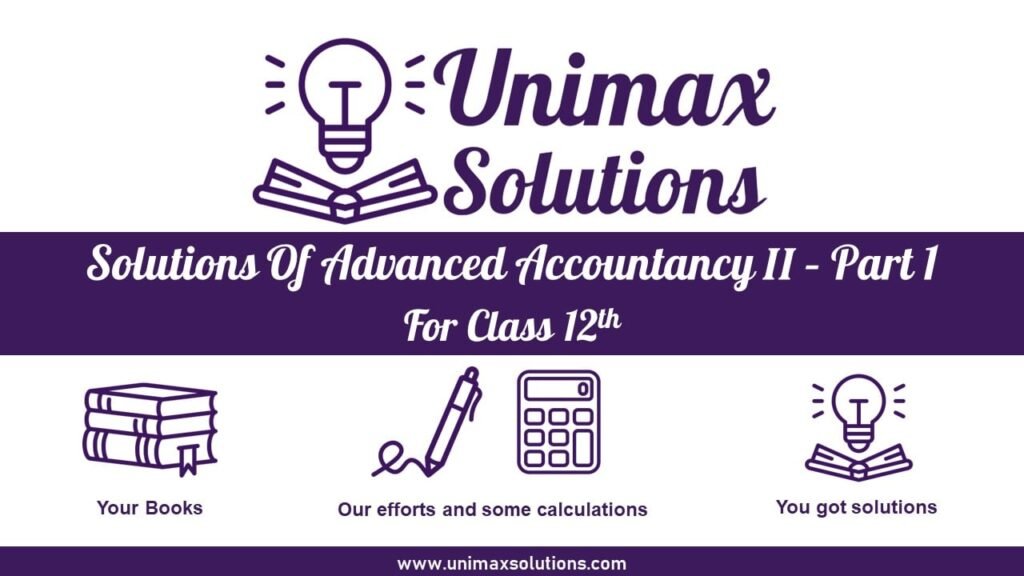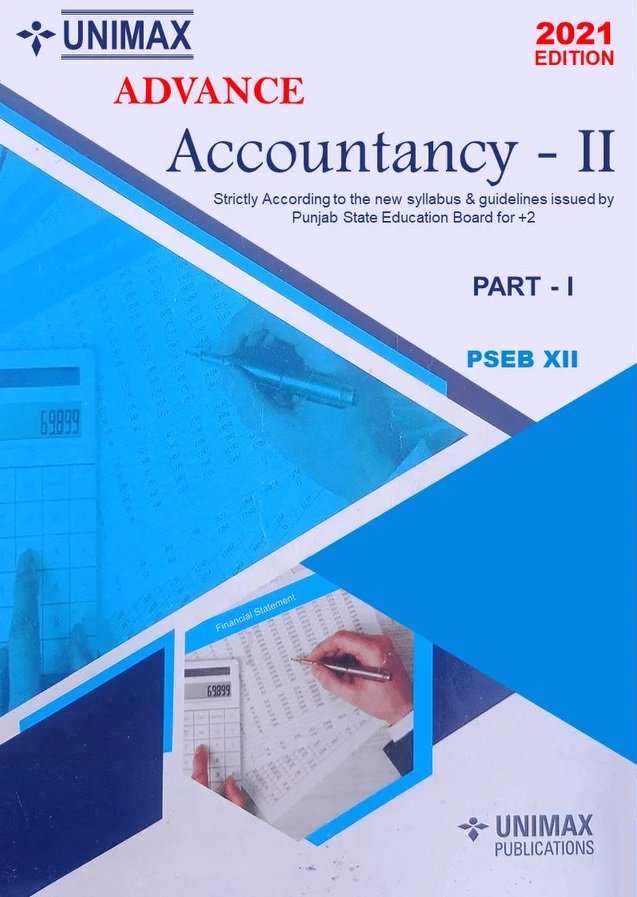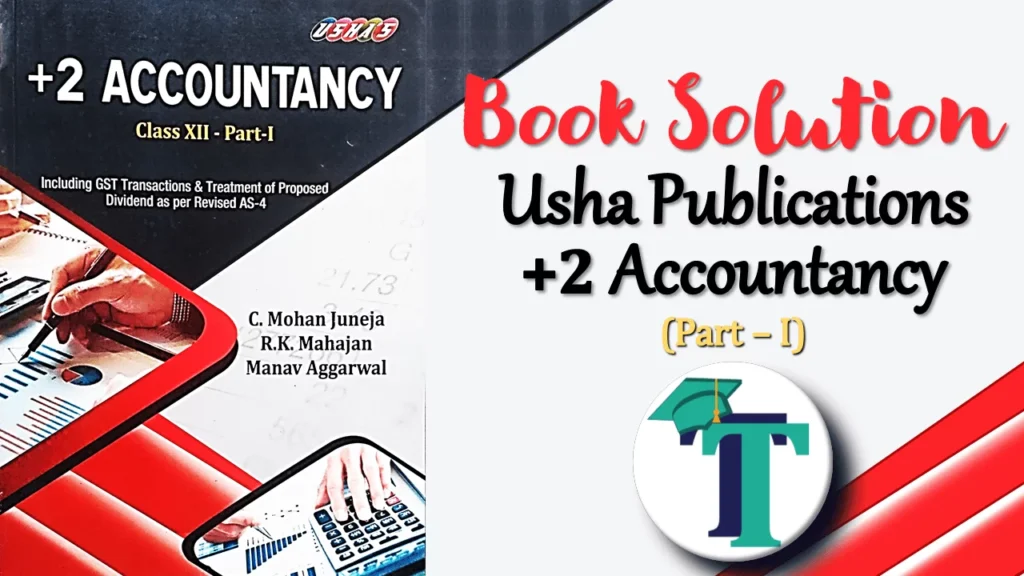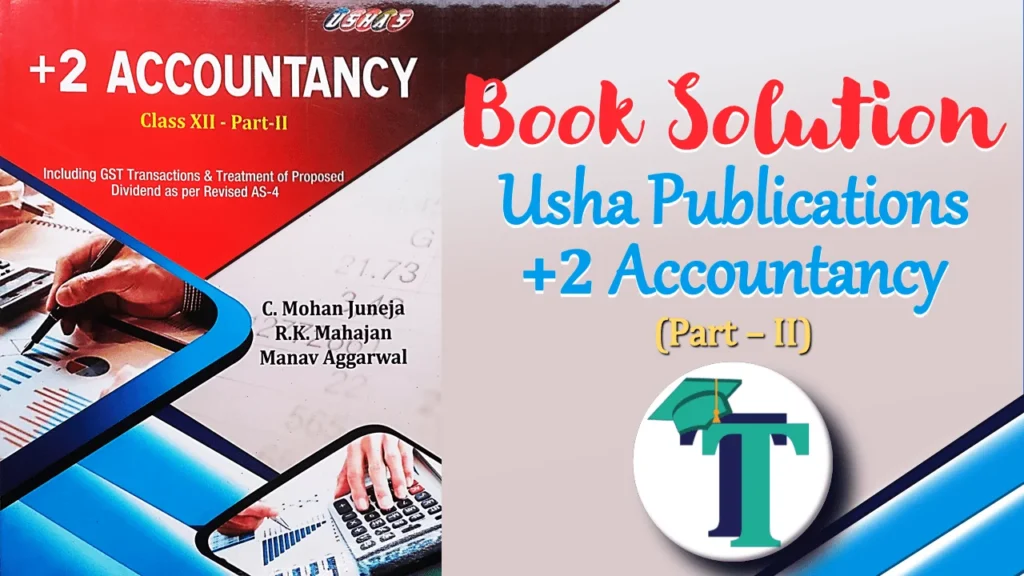
Advertisement
Are you a student of Class 12 studying accountancy? The solutions of Advanced Accountancy II Part 1 Class 12 by Unimax are here. They were authored by a team of experienced teachers and professionals in the field of accountancy. This Article covers all the Chapters in Part 1 of the above book.
The Unimax book of Class 12 accountancy is based on the syllabus issued by PSEB. We provide detailed solutions to all questions given in the textbook.
This article is for Class 12 students of PSEB only. For Class 11 please check out Advanced Accountancy I Class 11 – Solution for free.
Advanced Accountancy II Part 1 Class 12

The book has been designed to make accountancy easy to understand for students. It is written clearly and concisely, presenting even the most complex topics in a simplified format. The authors have adopted a step-by-step approach to explain the concepts.
Salient features of Advanced Accountancy II Part 1 Class 12 by Unimax:
- Conceptual clarity: The book focuses on building a strong foundation of accounting concepts. It explains the fundamentals of advanced accountancy logically and coherently. It will enable students to develop a clear understanding of the subject.
- In-depth coverage: The book provides an in-depth analysis of various topics, ensuring that students have a comprehensive understanding of the subject matter.
- Practice questions and exercises: The book offers a wide range of practice questions and exercises at the end of each chapter. These exercises are designed to test students’ understanding of the concepts and provide ample opportunities for them to practice solving problems independently.
- Revision notes and summaries: To assist students in their exam preparation, the book includes comprehensive revision notes and summaries at the end of each chapter. These summaries condense the key points and concepts, allowing students to quickly revise and reinforce their understanding before the exams.
- Latest accounting standards: The book incorporates the latest accounting standards and regulations issued by the relevant authorities. This ensures that students are up to date with the current practices and guidelines in the field of accountancy.
- Case-based questions: The book includes various case-based questions that require students to apply their knowledge to real-life scenarios. These questions enhance critical thinking and problem-solving skills, preparing students for practical challenges they may encounter in their future careers.
- Supplementary online resources: UnimaxSolutions.in provides supplementary online resources, such as additional practice questions, solutions, and interactive quizzes, to further support students’ learning and revision outside the classroom.
Overall, Advanced Accountancy II Class 12 Part 1 by Unimax offers a comprehensive and practical approach to the study of accountancy. With its detailed explanations, ample practice opportunities, and real-life examples, the book equips students with the necessary knowledge and skills to excel in their Class 12 accountancy examinations and beyond.
Solutions of Advanced Accountancy II Part 1 Class 12 by Unimax
For further assistance, the Advanced Accountancy II Part 1 Class 12 also provides comprehensive solutions to all the questions included within each chapter. Simply select the desired chapter name to access the solutions.
Chapter No. 1 – Accounts of Non-Profit Organisations:
This chapter aims to familiarize students with the accounting principles and practices applicable to non-profit organizations. Non-profit organizations operate to serve social or charitable purposes; consequently, they prioritize the well-being of communities over profit maximization. Examples of such organizations include charities, religious institutions, and educational institutions.
Advertisement
Within this chapter, students will explore various aspects of accounting for non-profit organizations. This includes understanding the preparation of income and expenditure statements, balance sheets, and cash flow statements specific to non-profit entities. Furthermore, the chapter delves into the various types of funds that non-profit organizations may possess. These include general funds, special funds, and endowment funds. The chapter also guides the appropriate accounting treatment for each type of fund.
Chapter No. 2 – Partnership Accounts – I (Basic Concepts):
This chapter serves as a foundation for students to grasp the basic concepts of partnership accounting. Partnerships are a form of business organization where two or more individuals come together to pursue profit-making activities.
Within this chapter, students will explore different types of partnerships, including general partnerships, limited partnerships, and limited liability partnerships. Moreover, the chapter delves into an extensive exploration of the various types of funds that non-profit organizations may possess.
Chapter No. 3 – Partnership Accounts – II (Goodwill):
In this chapter, students will delve into the concept of goodwill within partnership accounting. Goodwill represents the intangible value of a business, exceeding its tangible assets like buildings, equipment, and inventory.
Throughout this chapter, students will learn various methods to calculate goodwill, including the average profits method, the super profits method, and the capitalization method. The chapter also covers the treatment of goodwill during significant partnership events like admission, retirement, or the unfortunate occurrence of a partner’s demise.
Advertisement
Chapter No. 4 – Partnership Accounts – III (Change in Profit Sharing Ratio among Existing Partners):
This chapter of Advanced Accountancy II Part 1 Class 12 focuses on understanding and analyzing changes in the profit-sharing ratio among existing partners. Such changes may occur due to additional capital contributions, agreed-upon modifications in profit-sharing agreements, or changes in the business environment.
Within this chapter, students will learn about the accounting treatment for changes in profit-sharing ratios. This involves calculating revaluation profits or losses, adjusting capital accounts, and distributing revaluation profits or losses among the partners.
Chapter No. 5 – Partnership Accounts – IV (Admission of A Partner):
In this chapter, students will gain insights into the process of admitting a new partner into an existing partnership. The admission of a new partner may be prompted by various factors, such as the retirement or death of an existing partner, the need for additional capital, or the desire to bring in specific skills or expertise.
Throughout the chapter, students will study the accounting treatment involved in admitting a new partner. This includes valuing goodwill, adjusting capital accounts, and distributing profits and losses among the partners. Additionally, the chapter addresses the legal and financial implications of admitting a new partner, such as updating the partnership agreement and potential tax-related consequences.
Chapter No. 6 – Partnership Accounts – V (Retirement and Death of A Partner):
This chapter of Advanced Accountancy II Part 1 Class 12 delves into the accounting treatment of retirement and the unfortunate event of a partner’s death in a partnership. Such occurrences have significant financial and legal implications for both the remaining partners and the partnership as a whole.
Advertisement
Within this chapter, students will explore the accounting aspects related to retirement or the death of a partner. This includes valuing goodwill, adjusting capital accounts, and distributing profits and losses among the partners. The chapter also addresses the legal and financial consequences of these events, such as updating the partnership agreement, providing retirement benefits or death benefits, and the potential impact on the partnership’s tax status.
Chapter No. 7 – Partnership Accounts – VI (Dissolution of Partnership Firm):
This chapter of Advanced Accountancy II Part 1 Class 12 deals with the dissolution of a partnership firm, which occurs when the partnership is terminated voluntarily or involuntarily. Dissolution involves winding up the partnership’s affairs.
Throughout this chapter, students will learn about the accounting treatment during the dissolution of a partnership firm. This includes realizing and settling assets and liabilities, distributing capital and profits among the partners, and settling any outstanding debts or liabilities. Additionally, the chapter covers the legal and financial implications of dissolution, such as the requirement to file appropriate legal documents and the potential impact on the partners’ personal finances and credit ratings.
Reference: Tutorstips.com
Check out Comprehensive Solutions for All Chapters of Advanced Accountancy Part 2 Class 12 by Unimax
UnimaxSolutions.in presents an exceptional resource for students studying Advanced Accountancy Part 2 in Class 12. With their comprehensive study material, students can conveniently access extensive solutions to all the questions featured within each chapter. By simply selecting the desired chapter from the study material, students can effortlessly navigate through the topics and gain access to detailed explanations and step-by-step solutions to every problem presented in that particular section. Whether it involves understanding intricate accounting principles, honing calculation techniques, or analyzing complex financial statements, Unimax provides a valuable tool to support students in their learning journey. Equipped with these comprehensive solutions, students can enhance their comprehension, resolve any uncertainties, and strengthen their problem-solving abilities in Advanced Accountancy, empowering them to excel in their Class 12 examinations with confidence.
- Chapter No. 1 – Company Accounts (Share Capital)
- Chapter No. 2 – Issue of Debentures
- Chapter No. 3 – Redemption of Debentures
- Chapter No. 4 – Financial Statements of a Company (Balance Sheet Only)
- Chapter No. 5 -Financial Statement Analysis
- Chapter No. 6 – Tools/Methods of Financial Analysis
- Chapter No. 7 – Ratio Analysis
- Chapter No. 8 – Cash Flow Statement
Punjab School Education Board (PSEB) Solutions of Usha Publication.
If you’re a student enrolled in the Punjab School Education Board Class 12, it’s essential to explore a wide range of books to cover the syllabus thoroughly. While the prescribed textbooks are undoubtedly valuable, supplementing your studies with additional resources can enhance your understanding and knowledge. Consider checking out other books that align with the curriculum, offering different perspectives and insights on the subjects you’re studying. These supplementary materials can provide you with alternative explanations, practice questions, and examples that may aid in clarifying complex concepts. Moreover, exploring diverse sources can expose you to a variety of writing styles and viewpoints, fostering a broader understanding of the subjects. So, seize the opportunity to expand your learning by delving into other books that can complement your studies and contribute to your academic growth.
Advertisement


